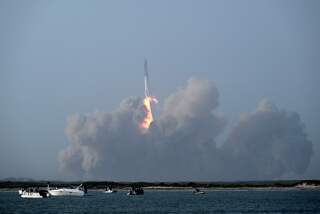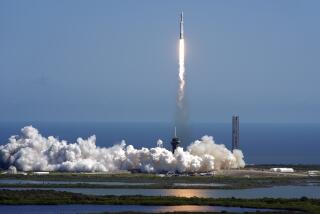SpaceX’s Crew Dragon capsule returns to earth. Next up: flying humans

SpaceX’s new crew capsule returned to Earth on Friday, ending its first test flight with an old-fashioned splashdown.
SpaceX closed out the first test mission of its Crew Dragon capsule with a successful splashdown Friday in the Atlantic Ocean, putting the company one step closer to its goal of flying humans to space.
The test flight, which despite the vessel’s name did not carry a crew, also propels NASA toward a future in which the agency’s astronauts can launch to the International Space Station from the U.S. in American-built spacecraft, rather than relying solely on Russia. The U.S. lost that capability when the space shuttle program ended in 2011.
“This is really an American achievement that spans many generations of NASA administrators and over a decade of work,” NASA Administrator Jim Bridenstine said during a livestream of the capsule’s landing. “It is a dawn of a new era.”
The Crew Dragon capsule launched early Saturday morning from Florida on a SpaceX Falcon 9 rocket. About a day later, it docked autonomously at the space station for the first time.
The test mission was the first launch of NASA’s commercial crew program — a public-private partnership in which the agency awarded Boeing Co. and Hawthorne-based SpaceX a combined $6.8 billion in contracts to each build a craft capable of taking astronauts to the space station. Boeing’s first uncrewed test flight is currently set for April.
Bridenstine has said NASA wants to be a customer for these types of operations in low-Earth orbit, rather than developing and owning its own spacecraft for the task. Already, SpaceX and Northrop Grumman Corp. deliver cargo capsules filled with supplies to the space station.
That would free up the agency to take on more expensive missions to the moon and beyond.
But the commercial crew program has faced several delays over the years, which pushed back test flights of the SpaceX and Boeing capsules. SpaceX’s first test flight with a crew is expected no earlier than July; Boeing’s is scheduled for no earlier than August.
In the meantime, the U.S. has extended its contract with the Russian space agency several times to buy more seats for American astronauts on its Soyuz capsule. A 2015 contract extension was valued at about $491 million, or about $82 million per seat, according to a 2017 U.S. Government Accountability Office report.
“The quicker we can become independent, the better it is for the space program,” said Marco Caceres, senior space analyst at market research firm Teal Group.
Although the SpaceX and Boeing capsules’ primary purpose is to transport NASA astronauts to the space station, both companies are looking at their potential use in the future for space tourism. Last week, SpaceX Chief Executive Elon Musk said that once Crew Dragon was in regular operation, “I think we will seek commercial customers.”
The Crew Dragon capsule undocked from the space station at 2:32 a.m. EST Friday after a five-day stay. About five hours later, a 15-minute de-orbit burn prepared the capsule for reentry, and it floated down into the Atlantic Ocean off the coast of Florida at 8:45 a.m., slowed first by two drogue parachutes and then four main parachutes.
Two SpaceX boats were nearby to complete safety checks on the capsule after it splashed down. SpaceX’s Go Searcher recovery ship, which is equipped with a helipad and medical treatment facility, lifted the Crew Dragon out of the water around 9:50 a.m.
“Some people had doubts that SpaceX could achieve this,” said Laura Forczyk, owner of space consulting firm Astralytical. “This is a real feather in the cap of SpaceX.”
The capsule was packed with more than 330 pounds of science equipment and other hardware from the space station. A mannequin passenger named Ripley, which rode in the capsule on the way up to the station and was laden with sensors to test the flight experience, also returned to Earth.
“The vehicle really did better than we expected,” Steve Stich, deputy manager of NASA’s commercial crew program, said on the livestream. “I don’t think we saw really anything in the mission so far … that would preclude us having the crewed mission later this year.”
But before that happens, SpaceX and NASA will pore over the data from this flight and conduct more tests.
The capsule used in this test mission will be reused in an in-flight abort test, in which the capsule will be launched on a rocket and then detached prematurely to try out the capsule’s emergency escape system. That test is set for June.
Bob Behnken, a NASA astronaut who flew on two shuttle missions — most recently in 2010 — and will be one of two astronauts on the SpaceX capsule’s first crewed test flight, said during the livestream that he was “super excited” about the uncrewed test flight.
“When I get back to the International Space Station, I’m really looking forward to seeing it complete,” he said. “I’m looking forward to getting back there and experiencing sunrises and sunsets up there. Can’t get that anyplace else.”
Twitter: @smasunaga
More to Read
Inside the business of entertainment
The Wide Shot brings you news, analysis and insights on everything from streaming wars to production — and what it all means for the future.
You may occasionally receive promotional content from the Los Angeles Times.











